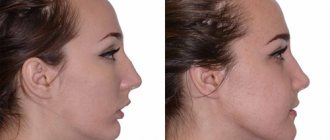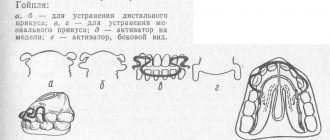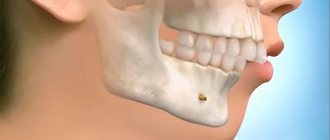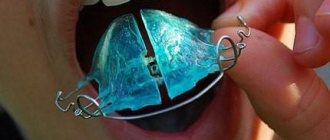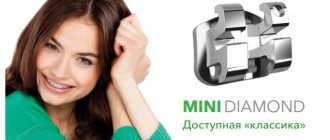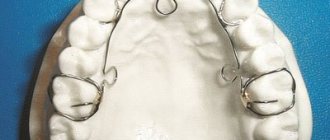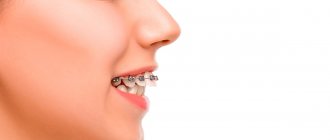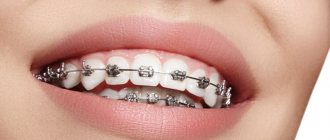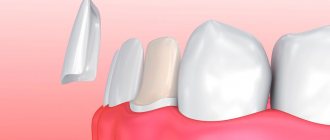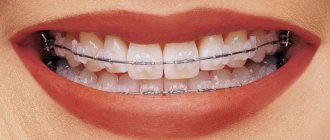Bite correction using Star Smile technology takes place at the dental clinic “On Smolenskaya” in several stages.
- At the first consultation, the doctor takes impressions and a panoramic image of the OPTG. The results of the examination are sent to the laboratory.
- Already during the second visit, the patient is shown a virtual setup - a three-dimensional video, which shows how the correction of irregularities in the dentition will occur and what the result will be.
- During treatment, the patient independently changes the aligners every two weeks, following the recommendations of the attending physician.
- Scheduled visits to monitor progress are carried out at intervals of 1-2 months.
To achieve results, you need to wear the aligners for up to 20-22 hours during the day - the aligners can be removed while brushing your teeth and eating. It is enough to follow simple rules of use and care - and the result in the form of perfectly straight, beautiful teeth will not take long to arrive!
“Physiological bite,” when the teeth are located symmetrically and the upper row overlaps the lower row by about a third, is very rare. There are many variants of the norm that do not require correction. However, in some cases, malocclusion becomes the cause of health problems, not to mention an unesthetic smile.
Dentists at the Na Smolenskaya clinic successfully practice correcting bites in adults using special mouth guards. This option looks more attractive than fixed orthodontic appliances (braces), which require strict hygiene. Now you can solve the problem comfortably without changing your usual lifestyle.
A mouthguard for correcting occlusion is a removable transparent orthodontic device made taking into account the individual characteristics of the patient. The aligner does not cause a foreign body sensation in the mouth, since it fits tightly to the teeth, repeating their location. The mouth guard puts constant pressure on the teeth, moving them in the desired direction.
For malocclusion correction to be effective, mouth guards must be worn on the teeth 22 hours a day. The aligner can be removed during meals and oral hygiene. At the start, the patient receives a set of trays and independently changes them as needed. The method is suitable for correcting any malocclusion.
What is a mouth guard?
A removable mouth guard is an orthodontic device designed to straighten the teeth. It is made exactly according to the dimensions of a particular patient and takes into account his individual anatomical features.
A plastic product is produced after computer modeling. The structures are made from a special biocompatible transparent material or silicone, depending on the purpose of the treatment.
Trainer mouthguards are intended for children and help correct the initial stages of defects. Retainers are used to train the jaw muscles after correction of defects. They help consolidate the result. Aligner trays serve directly to move the teeth.
Dentists recommend dealing with issues of bite correction from adolescence. If this pathology is not treated, then in addition to an unsatisfactory appearance, oral diseases (periodontitis and gingivitis) develop. With age, gastrointestinal dysfunction and constant headaches occur.
Correcting the bite in older patients takes longer and is more expensive, since the amount of work becomes much greater than in young people.
Mouth guards as an alternative to braces
Straightening crooked teeth, of course, should be done in childhood. However, many parents simply do not pay attention to this problem. Therefore, the question of orthodontic treatment for most patients arises in adolescence or adulthood. However, not every teenager or adult will agree to put braces on their teeth and follow not the most simple rules of hygiene. Until recently, there was no alternative to braces. But with the advent of aligners - mouth guards for straightening teeth, it became possible to undergo orthodontic treatment unnoticed by others and with comfort for yourself. Moreover, this applies not only to adults, but also to teenagers, for whom their own technology of transparent mouth guards has been developed. Like aligners for adults, they are a set of removable aligners, completely invisible to others, which can correct most dental anomalies, provided that the attending physician has the appropriate experience.
How the cap works
Mouthguards create a certain pressure on the dental apparatus. Under this influence, the teeth move in the desired direction. Mouthguards are made in exact accordance with each tooth, but exact repetition of a whole row of the upper and lower jaws is deliberately not allowed. Otherwise, the mouth guard simply will not work towards correcting the defect.
If the braces are not changed during the entire wearing period, but are only tightened, then the aligners must be periodically replaced. With each new product, the shape of the mouth guard changes. Sometimes the adjustment is 1-2 mm, so it is difficult for the patient to notice the difference. Teeth shift in 14-21 days when wearing a plastic structure occurs by exactly this amount.
When you first put on the mouthguard, you may experience some discomfort, which goes away within a couple of days. Occasionally, pain occurs in people with a low sensitivity threshold.
Transparent mouth guard for teeth straightening and trainers
Dental aligners for straightening teeth are often confused with trainers and retainers, which are worn after braces are removed. Meanwhile, these are completely different orthodontic devices, which have different indications for use and have different effects on the dental system. Trainers are somewhat reminiscent of sports mouthguards to protect teeth from impacts. With their help, it is possible to correct malocclusion and dental position in children from three years of age, which have developed as a result of impaired breathing and swallowing functions, as well as due to numerous childhood bad habits, such as prolonged sucking of a pacifier or bottle. Trainers are particularly effective for treating early stage malocclusions and are therefore mainly suitable for children under 11 years of age. A retainer is usually prescribed to consolidate the results of orthodontic treatment and adjust muscle function in accordance with the bite. It is bulkier than a clear aligner for adults and is made of flexible silicone.
Types of mouthguards for bite correction
By manufacturing method:
- standard mouthguards. They are produced according to a template without taking into account the individual characteristics of the jaw anatomy; when worn, they can create inconvenience and cause increased salivation;
- thermoplastic mouthguards. They repeat the shape of the tooth and harden after installation, which allows you to take into account the nuances of the patient’s jaw structure;
- individual mouthguards. They are made individually, taking into account all the features of the structure of the jaw and the shape of the teeth. They are easy to use and allow you to get good results in a short time.
According to the material:
- plastic and silicone mouth guards. Both materials are transparent, invisible and imperceptible on the teeth, hypoallergenic, and do not injure the gums/teeth.
By wearing time:
- night guards It is recommended to use for minor bite defects, at the last stage of dental treatment to consolidate the results obtained;
- 24/7. They are used to correct serious bite pathologies and are removed only for cleaning.
According to the age:
- children's. Mouthguards are easily removable, are not visualized, and differ from devices for adults only in size;
- adults. Their use is indicated for the correction of malocclusions.
Why does a malocclusion need to be corrected?
Malocclusion is not only an aesthetic problem. Over time, it leads to functional disorders:
- individual areas of enamel wear unevenly due to the increased load on them, increasing the risk of caries;
- gums become inflamed, periodontal disease develops;
- possible premature tooth loss;
- the face becomes asymmetrical, unaesthetic wrinkles appear;
- Due to difficulty chewing food, gastrointestinal disorders begin.
Differences between mouth guards and braces
The material used to make the orthodontic structure is of great importance. For bracket systems, ceramics, metal, and combinations of hard materials are used. In the first stages of therapy, this can lead to damage to the mucous membrane and soft tissues. Mouth guards are an excellent alternative to braces; they are made from high-tech plastic, which eliminates the possibility of unpleasant consequences:
- correction of bite with aligners and alignment of the dentition occurs unnoticed by others, braces are visualized in the oral cavity;
- Braces are produced in serial batches - this makes their selection difficult. The mouthguard for correcting the bite is made individually;
- Mouthguards are removable devices, which allows you to perform thorough cleaning yourself and minimize the risk of carious cavities.
The use of mouthguards does not impose restrictions on the patient’s diet. If you have braces, you will have to give up candy, chewing gum, nuts and other hard foods during treatment.
The use of each of these types of orthodontic structures is associated with the correction of different defects. Therefore, it is not correct to judge which option is better or worse. Mouthguards are necessary to correct small and medium bite defects, and braces will help with serious deficiencies.
Advantages of the method
What is good about the bite correction method we offer?
- They are invisible: the material is transparent. People around you almost never notice that their interlocutor is using “cases.” And braces, alas, give themselves away right away.
- They are easy to care for: just brush them with a soft brush without abrasive paste twice a day.
- They do not complicate normal oral hygiene: the aligners are worn 22 hours a day and can be removed for eating and washing. Yes, you can’t drink coffee, tea, juice in the “overlays”, only water. But our patients are sure: this is only for the better, because this creates balance in the drinking regime.
- They are hypoallergenic: this makes them indispensable for those who suffer from metal allergies or cannot perceive a metallic taste.
- They are easy to use: this saves time for the patient and the doctor. Minor discomfort may be present during the first day of using the new tray size.
- They do not injure enamel and soft tissues: which means the treatment will be comfortable.
Features of treatment with mouth guards
A professional mouth guard for correcting bites in adults is an arched silicone structure consisting of tongue guards, lip bumpers, and recesses for the teeth of the upper/lower jaws, separated by an imaginary plane (from the edges of the frontal incisors to the outer molars).
Silicone rubber has the ability to quickly return to its original position, due to which teeth are displaced in a short time. The mouthguards are made from an individual impression in a special laboratory, used in the order prescribed by the doctor, and changed every two weeks.
And then... children's aligners appear on the scene!
With the advent of new digital technologies, the orthodontist discovered the world of transparent orthodontics - a painless, convenient method that allows you to set the correct vector for the development of the child’s dental system. Children's aligners are clear aligners that allow teeth to be moved in early childhood.
The first breakthrough in treating children without braces was made by Invisalign. Check out their advertising slogan below - it compares aligners with wireless communication ( Go wireless
), and in context - wireless technology, which we always associate with the braces system (there are also braces and the wire connecting them). The absence of wires and heavy braces on a child’s teeth eliminates many obstacles, inconveniences and removes restrictions on nutrition and hygiene:
The technology of treatment with aligners for children is to align baby (temporary) teeth and also promote the proper growth of permanent teeth. “Children’s aligner, mouthguard – what is it?”, you ask, what is the difference from a plate, what is better to choose? And why don’t all orthodontists offer this type of treatment?
The answer, dear friends, is obvious; this type of dentition correction is a breakthrough for 2021. If previously we had the opportunity to treat adults using aligners, now - hurray! and thank you very much! manufacturers - Invisalign, Star Smile, Flexilainer - for providing the opportunity to correct the bite in children with the help of aligners.
What do children's aligners do as opposed to plates?
Unlike dental plates, bite alignment with aligners in children allows teeth to move in all planes in the same way as with aligners for permanent dentition in adults.
The initially specified correct vector of tooth movement in the aligner treatment technology makes it possible to straighten both the child’s already erupted teeth and those just beginning to erupt.
Thus, aligners for children contribute to the proper growth of permanent teeth.
Early treatment
. Treatment with aligners can begin from the age of 5 while still in the primary dentition. At this age, malocclusion in children is corrected quickly.
Aligners do not damage the enamel, and there are no dietary restrictions when wearing them. On the contrary, it is recommended to eat hard, wholesome foods (among them carrots, apples, cucumbers) in order to train the chewing muscles.
The treatment goes unnoticed by others, the child feels comfortable, they are easily removed and are not noticeable in the mouth
.
He won't be teased
, since the aligners are invisible when you talk or smile.
Alignment aligners are safer
, they are smooth, fit tightly to the teeth, the tongue does not catch on the children's aligner, and speech defects are less pronounced than with other orthodontic systems.
With children's aligners, there is no need to worry about food getting stuck in the aligner.
or hard parts of food will damage the aligners.
The child can brush his teeth and eat as usual: removable aligners do not interfere with hygiene
.
It is much easier for a child to care for aligners than for braces - no special brushes
. For care, simply rinse the aligners with warm water and a special solution or simply brush with a regular toothbrush.
Control of tooth movement on children's aligners
Using a special computer program, the doctor demonstrates the results of orthodontic treatment BEFORE it begins. In 3D format, the child and his parents will see how and in what time frame the teeth will move (a colorful cartoon).
All manufacturers have their own computer programs for 3D visualization of the final result of bite correction in children: Invisalign has the CleanCheck
, Star Smile has a virtual 3D setup, FlexiLigner has the OrthoCheck program.
At each stage of treatment there is a unique opportunity to carry out additional correction according to clinical need, for example: loss of a baby tooth, or premature eruption outside the dentition.
Visit to the doctor
. With early correction of primary occlusion using aligners, visits to the orthodontist are not frequent, once every 1.5-2 months is sufficient. A repeated visit to the doctor does not take much time; basically, the doctor gives the patient sets of aligners and takes photographs during the treatment phase. The appointment takes no more than 15-20 minutes.
Children need to wear aligners constantly, day and night, and remove them only when eating or brushing their teeth. Which is very simple, convenient and very comfortable even for the smallest children.
Diagnostic plan
Initially, the clinic conducts a consultation and initial examination, during which the orthodontist assesses the general condition of the oral cavity, the position of the teeth, the severity of occlusal defects and determines how appropriate correction with a mouth guard is:
- orthopantomogram. A panoramic photograph of both jaws allows us to exclude the presence of unerupted teeth;
- 3D tomography. Helps deeply examine soft tissues, assess the health of the jaw, joints, teeth;
- casts. Necessary as a basis for modeling in the manufacture of mouth guards;
- photo of rows. Needed for visual inspection;
- sonogram. Detects disturbances and noises in the functioning of joints;
- establish functional and aesthetic aspects: preliminary thickness, routes of administration, occlusal schemes.
During diagnostic procedures, the jaw is determined for the production of a mouthguard. It can be complete (on both jaws), maxillary, mandibular. The final choice depends on medical indications, the condition of the oral cavity, and the severity of the pathology.
Indications for the use of children's aligners
- Uneven teeth, crowding of teeth in the anterior region caused by a discrepancy in the size of the teeth and jaws
- Gaps between teeth (diastema) more than 2-3 millimeters.
- Prevention of improper eruption or non-eruption (retention) of canines
- Correction of the position of teeth in the absence of the rudiments of some teeth (congenital adentia), preventing the shifting of adjacent teeth.
- Correction of crossbite in the anterior region or in the area of individual teeth.
- Correction of blocking of individual teeth and their introduction into the dentition.
- Early correction of incorrect rotation of teeth and return them to normal position before the final formation of roots.
- Treatment of incorrect position of the front teeth in combination with gaps between the teeth.
- Expansion of the upper and/or lower jaw.
Commentary by orthodontist M.N. Ostroukhova: “Children’s mouth guards for correcting bites are applicable in many cases. They are easy to use, easy to maintain dental hygiene, and give good results. In my practice, I use children’s aligners both independently and in combination with other devices for the most effective results.”
Stages of making a mouth guard
After diagnostics and taking impressions, a model is formed:
- computer technology. A 3D sample is created with an accurate calculation of subsequent aligners, which frees the patient from visiting the dental office to make intermediate impressions during treatment; models are made on a 3D printer. They can be used for vacuum or spray forming of the product;
- manual method. Less accurate, requires the creation of intermediate tray impressions during the course of correction.
Installation:
- Diagnostics. A comprehensive examination by a specialist who will analyze the location/structure of the teeth and take impressions of the jaws;
- Making diagnostic models of jaws and sending them to the laboratory;
- Visit doctor. The orthodontist puts on the finished device, prescribes medications if necessary, and gives recommendations on wearing and caring for the aligners.
At each stage of treatment, the mouthguard exerts constant pressure on the teeth in a given direction. For further correction, the aligners are changed once the desired alignment of the teeth is achieved.
The standard kit includes 10-40 caps. To correct defects, they must be worn daily for 20-23 hours; the duration of therapy is determined by the severity of the deformation of a number of teeth: minor deviations are corrected in 7 months; in complex cases, it is necessary to wear aligners to correct the bite for 1-2 years.
How does a dental mouth guard work?
The principle of operation of polycarbonate “linings” is very simple. It is based on an accurate calculation of the force of plastic pressure on the teeth and 3D computer modeling of the process. Based on the patient’s impression, the required number of “onlays” are made for the entire duration of treatment. Each of them will be used for about two weeks, and then replaced with the next size.
Our client in Moscow can see the future result of treatment in advance. Thus, he can not only, together with the doctor, correct the picture as he needs, but also receives motivation to continue treatment and not stop. And since you will have to wear the “pads” for several months, the attitude is extremely important for success.
Indications:
- rotation of teeth;
- mesial, cross, distal, open bite;
- trema/diastema;
- deep bite;
- gum disease;
- pathological crowding of teeth growing out of row or overlapping each other;
- increased abrasion of units;
- pain, dysfunction of the temporomandibular joints;
- bruxism (involuntary grinding of teeth at night);
- improper functioning of the chewing system;
- disruption of the facial musculo-ligamentous apparatus.
Doctors recommend using mouthguards to correct minor abnormalities in adult patients with severe crowding. That is, in all cases, the same as braces. Often used to correct bites in children with inadequate eruption of permanent/baby teeth. Wearing these lightweight systems is recommended after treating a bite with braces - the mouthguards help consolidate the positive effect comfortably and painlessly for the patient. .
Contraindications:
- lack of natural teeth;
- the presence of foci of inflammation in the oral cavity;
- caries;
- worsening gum disease;
- presence of impacted teeth.
Silicone aligners for teeth straightening
Treatment with clear aligners minimizes the risk of medical error. The fact is that while wearing braces, the dentist takes a very active part and is independently involved in their installation and corrections, and in the process he may make a mistake. As a result, the course of treatment and, as a consequence, its outcome may be disrupted. In addition, during the next correction, there is a risk of “tightening” the ligature, which can cause severe pain and “eversion” of the roots of the teeth. A transparent mouthguard for straightening teeth for adults acts on hard tissues very smoothly and, if the doctor initially correctly calculated the trajectory of teeth movement, cannot disrupt the course of treatment.
pros
The dental system is invisible in the oral cavity, does not cause discomfort, and can be used by children and adults:
- aesthetics. Orthodontic plates are more aesthetically pleasing than braces, and therefore provide patients with 100% psychological comfort;
- hygiene. Do not make it difficult to perform hygiene measures in the oral cavity;
- predictability. The doctor has the opportunity to clearly show the planned result and individual stages of therapy;
- shorter wearing period;
- guaranteed absence of relapses;
- when installing the device, rapid adaptation occurs - within 20-30 minutes the patient gets used to the device;
- does not provoke pain, discomfort, does not impair diction;
- does not harm the enamel, does not injure the mucous membranes and gums, and does not cause pain.
Flaws:
limited indications (presence of pathological problems: cracks, narrowed/widened arch, not pronounced displacement of the rows), high cost, long course, dependence of the effectiveness of the result on non-compliance/implementation of the doctor’s recommendations, risk of injury to the gum edge.
Care of mouth guards
Caring for this structure does not cause any difficulties. It is enough to follow just a few rules:
· brush your teeth regularly, during hygiene use not only a toothbrush and toothpaste, but also toothpicks and floss;
· after each meal, rinse your mouth with water or a special solution;
· before putting on the mouthguard should be rinsed with warm water;
· orthodontic structures must be cleaned regularly with a soft brush using a special product from the same manufacturer as the mouth guards, or with toothpaste without abrasive particles;
· strictly adhere to all the dentist’s recommendations and regularly visit him to examine the mouth guard, replace it, and also monitor the dynamics of the treatment process;
· the structure should be stored in a special box, which usually comes complete with a mouth guard;
· it is forbidden to disinfect by boiling, since in this case it will be deformed; it is best to use special antiseptic agents.
The best aligner manufacturers
- Invisalign. Modern, safe and effective products, which have received a lot of reviews, are made from transparent plastic on an individual basis. Comfortable, easy to care for, invisible, do not irritate mucous membranes/gums. The main advantage of the Invisalign system is the presence of the ClinCheck program, which allows the doctor to carry out virtual treatment using a 3D model in order to predict the real one and simulate the optimal design;
- OrthoSnap. Relatively new product on the market. The plates are made of soft plastic, fit securely to the teeth, do not rub tissue, and are inexpensive;
- Star Smile. Some of the best Russian products, the production of which uses computer technology. They are safe, hypoallergenic, easy to remove, do not affect diction, and have an affordable price.
Contraindications for the use of pediatric aligners
- Lack of motivation for treatment in parents and children. Moreover, the participation of parents here is very important, since the child is still small enough to expect from him a balanced and independent decision and compliance with all the orthodontist’s recommendations.
- Impaired nasal breathing (ENT pathology).
To eliminate ENT problems, Dial-Dent employs an otolaryngologist, Andrey Valerievich Arkhandeev. He performs endoscopic diagnostics and diagnostics using computed tomography of the sinuses (computed tomography of the sinuses can be done directly at a doctor’s appointment). Correct diagnosis and competently prescribed treatment help get rid of many ENT problems.
Rules for care and wearing
To achieve the effectiveness of bite treatment with mouthguards, you should strictly and strictly follow the rules for wearing the product. The patient is recommended to wear the mouthguard constantly, taking breaks only for meals and hygiene procedures. This is especially important for the initial period of active jaw movement. If you do not put on the device for 4-5 hours, the process may slow down significantly or even roll back to where dental treatment began.
Visits to the orthodontist should not be missed, since the treatment process involves constant adjustments to the product so that the teeth can move in the desired direction without stopping. Be prepared to visit the clinic 1-2 times a month. If you don’t arrive on time, the movement will stop and you will have to get used to the new mouth guard again.
Rules of use:
- When eating, remove the product from your mouth;
- Rinse with clean water after removal. It is strictly forbidden to dry it near a hot spring or boil the apparatus;
- after removing the aligners, thoroughly clean your teeth from food debris/plaque; it is recommended to use a toothpaste, brush, antibacterial rinse, and floss;
- store removable aligners in a special container.
The correct way to wear an orthodontic system is to wash it regularly, keep it clean, and use a disinfectant solution to prevent the formation of plaque.
How much do teeth straightening trays cost?
Aligner aligners are one of the most expensive methods of bite correction, but their cost is fully justified by the effect and comfort of use. It is important to note that you should not trust manufacturers who immediately name a fixed amount - you can find out the full cost only after an examination and consultation with an orthodontist. Based on the complexity of the problem, the specialist will draw up a treatment plan, which will indicate the number of mouth guards required for this particular case, the frequency of visits to the doctor and additional structures. These criteria determine the final cost of treatment. All manufacturers of aligners must explain in detail to patients what factors affect the price of the product.
Prices for correcting malocclusion with mouthguards in adults
The final price at Dr. Razumenko’s clinic in Moscow consists of the cost of radiography, impressions, jaw modeling, a set of products, work and control of a specialist, and a model of aligners. A plate for the correction of dentoalveolar anomalies in adult patients in our dentistry costs 4-20 thousand rubles, a full course of correction will cost 100-250 thousand rubles (10-20 overlays).
To calculate the price of mouth guards for correcting malocclusion in adults, sign up for a consultation with our dentistry. This can be done by filling out an application on the website or calling: 8 (495) 380-01-38.
| Code no. | Name of procedures | Unit of measurement | Cost, rub. |
| 703 | Taking a two-layer A-silicone impression | 2 000,00 | |
| 704 | Removing a two-layer polyester print | 3 000,00 | |
| 907 | Dynamic observation of the patient using the Invisalign/Star Smile system | 3 500,00 | |
| 977 | Full course (from 14 aligners) made in the Invisalign laboratory | 280 000,00 | |
| 978 | Invisalign treatment for mild to moderate clinical cases | 110 000,00 |
* The prices indicated on the website are not a public offer. The exact cost of treatment can only be determined at an appointment with a doctor.
Prices for treatment in Moscow full price list
Share on social media networks:
Article Expert:
Oganesyan Diana Feliksovna
Dentist-orthodontist. He regularly improves his professional level and studies modern methods of orthodontic treatment at international seminars and conferences of outstanding orthodontists in the world. He is a member of the Italian Society of Orthodontists (SIDO) and the European Aligner Association (EAS).
Work experience over 6 years
How to install a mouthguard
We will tell you what the patient needs to do to make his smile perfect.
Make an appointment with an orthodontist at our clinic. At the first visit, the doctor will carefully examine the oral cavity, identify possible indications and contraindications for wearing mouth guards, and discuss the treatment plan and cost of the products. If necessary, you will be referred for treatment of problem teeth.
Next comes the making of an impression from medical silicone and the necessary diagnostic images. At this stage you will see what your bite will look like in a few weeks. Modeling is carried out using computer programs; if necessary, the doctor will make the necessary adjustments.
Then there is the waiting time. You need to be a little patient while specialists in the laboratory make individual “cases”. When they are ready, the doctor will invite you to your next appointment.
Now it's time to learn how to use mouth guards. The orthodontist will show you how to do this, how to avoid unpleasant sensations, and how to properly care for them. At that time, a visit will be scheduled to change the set to the next one. The duration of treatment depends on the complexity of the problem being solved: in mild cases, 3 months is enough, sometimes you have to wear the “overlays” for more than a year. But it’s worth it: the effect becomes noticeable very quickly, after 1-2 months, and correcting your bite will protect you from many problems in the future.
We recommend that you read
Invisalign
Teeth straightening
Correction of bite with mouth guards
Canal filling
How the aligners work
Aligners are custom-made, removable, thin, clear plastic trays molded to the shape of the dental arch that the orthodontist seeks to create. This is a mirror of the future of your bite - what it will look like in 2 weeks. They move the teeth into the desired position.
To do this, first an impression is taken from the patient's jaws and a plaster cast is created. The aligner is then created using special 3D modeling software.
How long does it take to make aligners?
Based on the created 3D simulation, the required number of pairs of mouthguards are manufactured and sent to you within a few weeks.
The aligners move the teeth in controlled steps and very gently. Each individual tray applies slight pressure to the teeth and thereby moves them into the desired position. At the beginning of each phase, patients usually feel a slight pressure, but after a few days the sensation disappears.
Depending on the course of treatment, you will receive from 3 to 9 pairs of aligners. They are changed every 2-3 weeks. Unlike braces, mouthguards do not have adjustable elements. Instead, new designs are created for each individual stage of treatment.
How long should you wear aligners to straighten your teeth?
The course of bite correction with mouth guards lasts on average from 9 to 18 months. The duration of treatment and the timing of wearing aligners depend on the degree of required tooth displacement and the individual plasticity of the patient’s bone tissue.
Is it possible to correct an overbite with aligners?
Only an orthodontist can definitely say whether aligners will help with a malocclusion, and only after an examination, a full examination and special calculations. Aligners are often used for minor orthodontic pathologies, and whether the aligners will correct the bite in your particular case will become known only after a comprehensive examination and an accurate diagnosis. The main use of these structures is correction and fixation after a course of treatment with braces.
What do aligners fix?
Treatment with plastic splints is possible for both mild and severe forms of incorrect position of the teeth and the entire bite.
The following pathologies can be corrected with the help of orthodontic aligners:
- Crowding of teeth: When there is a lack of space in the jaw, it causes the teeth to move in different directions, tilt and turn out. Due to the grouping of teeth and their incorrect position, gingivitis, periodontitis, and caries often develop; Oral hygiene becomes significantly more difficult.
- Wide gaps between teeth occur when the jaw is large and the teeth are naturally small or some of them are lost.
- Crossbites and reverse bites are pathologies of teeth closure, in which misalignment and incorrect overlap of some teeth with others occurs. This leads to the occurrence of periodontal diseases, faster wear of teeth and their forced early loss.
- A deep bite is a variant of pathological occlusion in which the teeth of one jaw overlap with others too much. This leads to frequent injuries, the development of periodontal disease and even more severe tooth displacement.
- Incorrect position of individual teeth: there are violations of the placement and position of teeth, such as tilting, rotation (turning around its axis), displacement in one direction or another.
Are there any contraindications to treating malocclusion with aligners?
There are no strict contraindications for the use of these drops. The main thing is to keep your teeth and gums healthy. Before correcting the bite, sanitation of the oral cavity is always carried out: treatment of caries and its complications, acute inflammatory processes, professional hygiene - all this will ensure a good prognosis for orthodontic treatment and increase the effectiveness of the aligners.
Trainers for children
Trainers are mainly used at an early age - from 3 to 9 years, during the period of baby teeth and mixed dentition. They correct defects in the development of the dental system associated with various dysfunctions.
Often problems with bite are complex, for example associated with improper breathing. In particular, a small child may have enlarged adenoids, he cannot breathe fully through his nose and uses his mouth to do this. If this continues for a long time, then a number of problems arise.
- The upper jaw is formed incorrectly - it narrows in the lateral sections, as a result there is not enough space for the eruption of permanent teeth.
- Improper development of the upper jaw causes developmental defects in the lower jaw, and diction suffers from this.
- The muscles of the lips, tongue, and cheeks also do not work correctly, which negatively affects the aesthetics of the face: the neck is pulled forward, the lower third of the face lengthens, and the middle zone is poorly developed.
- The child cannot swallow fully, which affects digestion.
In this case, the orthodontist may recommend wearing trainers - they help the eruption of permanent teeth, develop the muscles of the oral cavity, help restore proper breathing, and shape posture. These mouthguards are worn during the day for several hours and throughout the night. The treatment process can be supplemented with developmental exercises.
Advantages and disadvantages: what is better to know in advance?
We have already briefly described the comparison of aligners and braces for a child. For the bite and its formation, mouth guards will be a gentle tool. Positive features:
- simple removable device;
- no restrictions on food;
- no complications with hygiene procedures;
- the development of caries during wear is excluded;
- no damage to gums or enamel;
- quick addiction;
- preservation of the original appearance - transparent material is invisible.
Negative aspects may arise: you need to convince the child not to remove the children's mouth guards on their own in order to maintain the effect. Motivation from parents and doctors helps here. Among the disadvantages, we note that aligners are perceived as an expensive treatment option, although with a full calculation, you will be convinced that the final cost of a similar treatment with a brace system is comparable in cost.
Although these disadvantages seem insignificant if you focus on practicality and absence of pain. For children, these parameters seem to be the most important.
Features of the devices
Mouthguards resemble caps for the entire dentition. They fit tightly to the surface of the units, so they are practically not felt. Thus, bite correction occurs without the discomfort characteristic of wearing braces (impaired diction, trauma to the mucous membrane, difficulty in hygiene).
The devices are made from plastic but durable materials (silicone, plastic, other polymers). The mouth guards are colorless, so they are not visible to others even at a short distance.
Correctors are recommended for use by adults and children. To correct malocclusion in childhood, special LM activators are also used to train the facial muscles, as well as stimulate proper teething.
